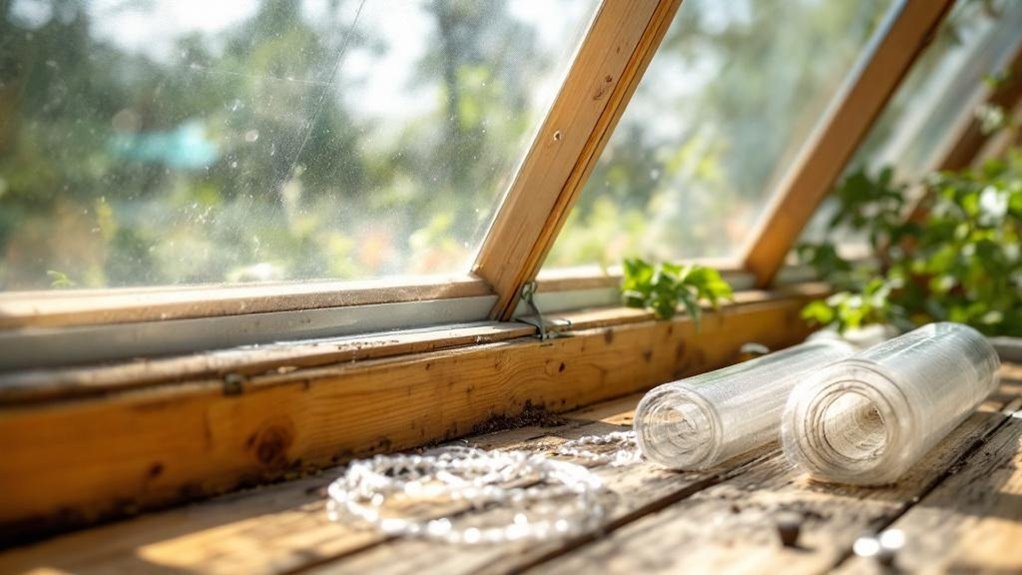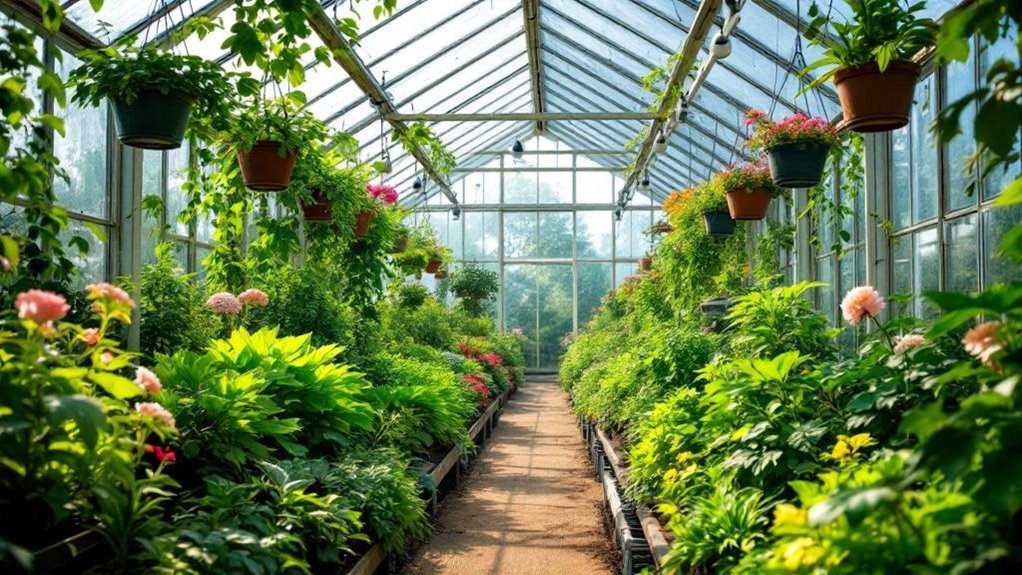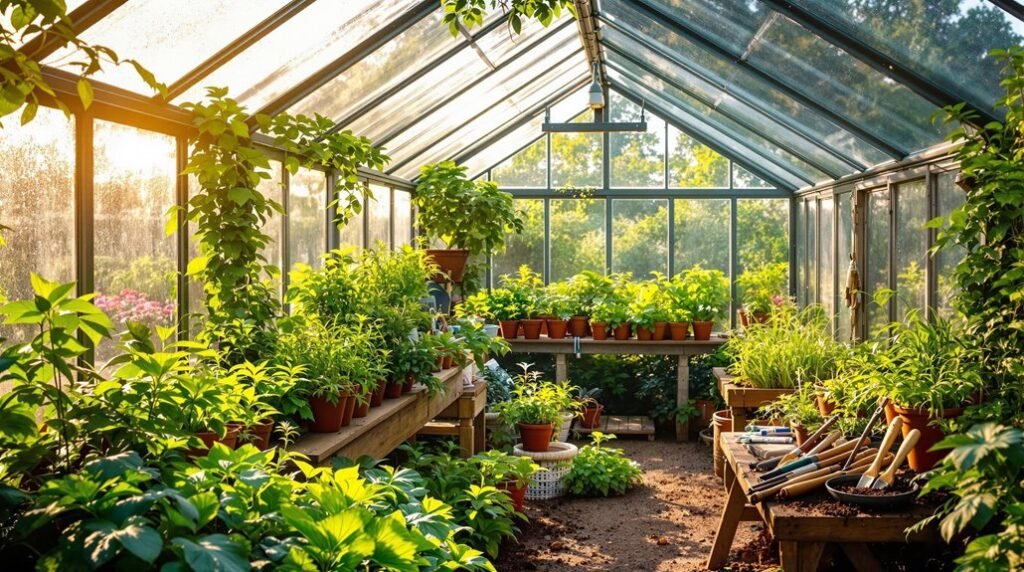Imagine stepping into a space where sunlight filters through clear panels, warming the air around your thriving plants. If you want to create that controlled environment for your garden, you’ll need to make thoughtful choices—from selecting the right structure to managing ventilation. The process might seem straightforward, but there are essential details that can make all the difference in your greenhouse’s success. Let’s explore what it really takes to build one that lasts.
Selecting the Right Greenhouse Type and Size
When choosing the right greenhouse type and size, you should first consider your available space, gardening goals, and local regulations.
Cold-frame greenhouses suit small areas, offering a simple controlled environment to boost plant growth. Attached greenhouses connect to your home, making it easier to access utilities, while standalone greenhouses provide maximum flexibility and space for diverse gardening needs.
Cold-frame, attached, and standalone greenhouses each offer unique benefits tailored to space and gardening preferences.
The ideal greenhouse size often exceeds the common 8 by 6 feet to allow room for plant growth and movement. A 1:3 ratio between width and length guarantees ample space for tasks and future expansion.
Before you build, check local zoning laws and building regulations since smaller greenhouses mightn’t require permits, but larger ones usually do.
Choosing the right greenhouse types and size optimizes your gardening success.
Preparing Your Site and Foundation
Although selecting the right greenhouse is vital, preparing your site and foundation lays the groundwork for a successful build.
Start by checking local zoning laws and securing any necessary building permits to avoid legal issues. Choose a location with full sun exposure, preferably facing south, and guarantee good drainage to prevent water pooling.
Level the ground carefully, as site preparation is critical for stability. For the foundation, opt for treated wood or concrete, making it slightly larger than your greenhouse base to enhance stability and deter pests.
If you prefer not to use a traditional foundation, lay landscape fabric beneath gravel or bricks to promote drainage and block weeds.
These steps guarantee your greenhouse rests on a solid, well-prepared foundation, setting you up for gardening success.
Building the Frame and Choosing Covering Materials

After securing a solid foundation, you’ll turn your attention to building the greenhouse frame and selecting the right covering materials.
Choosing durable building materials is essential for a stable greenhouse structure that withstands weather challenges. You might opt for a wood frame using treated wood for longevity and appeal, or lightweight PVC for easy assembly, especially if using greenhouse kits.
Durable materials like treated wood or lightweight PVC ensure your greenhouse stands strong through all weather conditions.
When selecting covering materials, consider how they affect temperature control and air circulation. Here’s what to keep in mind:
- Polycarbonate panels offer UV resistance and excellent insulation
- Glass provides clarity but requires tempered options for safety
- Plastic sheeting is affordable but less durable
- Treated wood frames resist rot and pests
- Aluminum frames combine strength with rust resistance
Pick materials tailored to your climate and plants for the best results.
Installing Ventilation and Climate Control Systems
How can you keep your greenhouse environment comfortable and healthy for your plants year-round? Start by installing roof vents and adjustable vents to enhance airflow and regulate temperature effectively. Incorporate electric heaters and maintain constant fan operation during colder months to distribute heat evenly. Adding thermal mass elements like water barrels helps absorb and release heat, boosting temperature control. Thoughtful greenhouse design guarantees your climate control systems work efficiently.
| System Component | Purpose | Benefit |
|---|---|---|
| Roof Vents | Improve airflow | Releases hot air, cools space |
| Electric Heaters | Provide heat | Keeps plants warm in winter |
| Thermal Mass Elements | Store and release heat | Stabilizes temperature swings |
These elements create a balanced environment, optimizing growth throughout the seasons.
Enhancing Your Greenhouse for Optimal Plant Growth

Maintaining proper ventilation and temperature control sets the foundation for a thriving greenhouse, but enhancing your space further can make a significant difference in plant health.
To achieve peak growth, consider these improvements:
- Use ventilation systems with roof vents and fans to regulate temperature and boost air circulation.
- Add thermal mass, like water barrels, to moderate temperature swings during cold nights.
- Monitor humidity levels closely and ventilate as needed to prevent mold and mildew.
- Install greenhouse shelves to maximize space and improve airflow around plants.
- Incorporate shade cloth or adjustable blinds to protect plants from intense sunlight and control light exposure.
Frequently Asked Questions
How to Construct a Greenhouse Step by Step?
You start by choosing your greenhouse type, then pick durable framing and covering materials. Next, level and prep your site for sunlight. Assemble the frame securely, add ventilation, and guarantee everything’s stable for healthy plant growth.
Is It Cheaper to Build a Greenhouse or Buy One?
You’ll save money building your own greenhouse, usually around $1,600 for materials, compared to $11,000 professionally built. DIY kits cost more but offer convenience. It depends on your budget, time, and customization needs.
Do I Need a Permit to Build a Greenhouse in My Backyard?
You’ll need to check with your local zoning office because permit requirements vary. Small backyard greenhouses usually don’t need permits, but larger or commercial ones might. Don’t skip this step to avoid fines or removal.
What Is the Best Way to Layout a Greenhouse?
You should orient your greenhouse south or southeast for maximum sunlight. Arrange shelves at various heights, place taller plants centrally or at the back, and keep pathways wide. Include organized zones for tools and potting tasks.
Final Thoughts
Now that you’ve built your greenhouse garden, imagine stepping inside a sunlit haven where vibrant leaves stretch toward the warm glow. You’ve created a nurturing space that hums with life, protected from the chill and bursting with growth. With each carefully chosen element—from sturdy frame to gentle ventilation—you’ve crafted a thriving oasis. Get ready to watch your plants flourish, turning your greenhouse into a peaceful retreat filled with nature’s quiet magic.
